BAD SEEDS? NO SEEDS?
Edamame Scare
Got a couple of scares in the garden this season. No, not some woodchuck making its way past the dogs and then through some openings in the fences to chomp down a row of peas (which look especially vibrant this year, thank you). And no late frost that wiped out my carefully tended tomato transplants.
The first scare came last week as I looked down on the bed where I had planted edamame a couple of weeks previously. No green showed in the bed, a stark contrast to the nearby bed planted at the same time with snap beans, the small plants enjoying the warm sunshine and neatly lined up four inches apart in two rows down the bed.
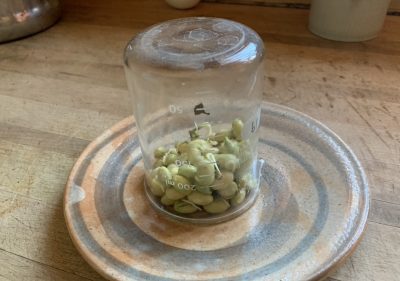
Testing edamame seeds
Scratching gingerly into the soil of the edamame bed did not reveal any seeds germinating but not yet above ground. In fact, I couldn’t find any seeds at all! Had I opened furrows and forgotten to plant seeds in them before covering the furrow? Doubtful, especially since I had planted another bed, still barren, in the other vegetable garden at the same time. Had a mouse or some other animal cruised underground enjoying a snack every four inches down the row? That would be a very thorough rodent. Plus, he or she would have left a tunnel.
Had the seeds rotted? Possibly, but that would be very quick for them to so thoroughly disappear. Had the seeds been old, which would make them more prone to rotting? I do save my own edamame seed every year, the variety Shirofumi, so that is a possibility. Except that I planted last year’s seed.
The mystery still exists but there was still time for action. I had additional Shirofumi seed left. Rather than just plant it, I’d test its germination, which I did by sprouting the seeds indoors. After an overnight soak in a beaker, I poured off the water and then rinsed the seeds twice daily. As it turned out seed from 2018 and 2015 didn’t germinate at all.
Last year’s seed germinated very well, and I planted them while their root sprouts were still very short. One week later, the plants have emerged. But the mystery still exists.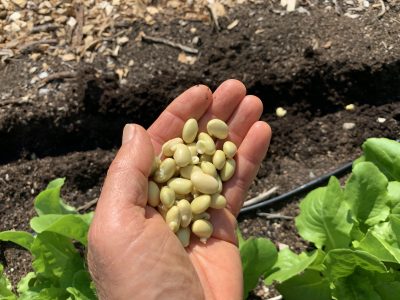
What If?
The second scare of the season is seed-related but hypothetical. What if seeds are unavailable next year, or any year? Or, at least, seeds of some of the varieties I want to grow.
This fear is not all that hypothetical. This spring, because of the surge in interest in gardening, seeds were harder to get.
And in years past, seeds of some of my favorite varieties of vegetables became difficult to find. Sweet Italia pepper, for instance, which I consider the best as far as flavor and early ripening for colder climates. My recourse has been to save my own seeds of these varieties for many years. In addition to Sweet Italia, I also save seed of Pink Pearl and Pennsylvania Dutch Butter popcorn, Otto File polenta corn, and, as mentioned above, Shirofumi edemame.

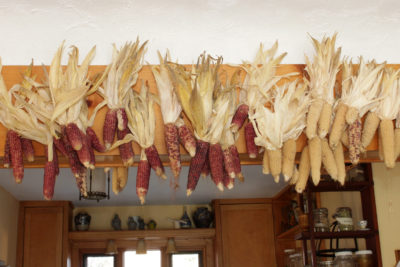
This season, the plan is to save seed of more vegetables.
A few guidelines will make seed-saving a success. First, I won’t save seed from “F-1 hybrids;” they are produced with selected, different parents, so the saved seed will not yield the same variety as the seed that is saved.
Selecting seeds from too few individuals can result in inbreeding depression, or generally weaker plants. So my second guideline is to save a few seeds from a lot of plants, then combine them to put more genetic diversity into the seed packet packet. Saving seed from more than one plant also provides insurance just in case a seed plant dies.
Some vegetable plants — corn, onions, and the cabbage family, for example — are especially prone to inbreeding depression. Saving seeds from Otto File and my popcorns is especially easy since the seeds are dry and mature when ready to eat or save. When I twist the kernels off an ear for eating, I just take out a few to add to my growing seed packet of that particular variety.
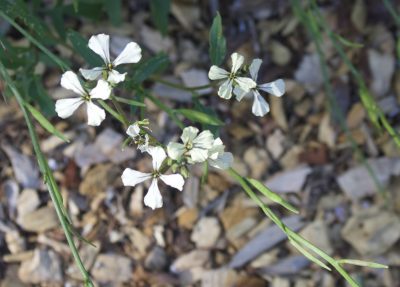
Arugula (Cabbage family) flower and seedpod
A third consideration in saving seed is keeping the seed true to variety. Varieties of sweet corn readily cross-pollinate. Again, it is corn, onions, and the cabbage family that are among the common vegetables that readily cross pollinate. So I grow popcorn in one vegetable garden and sweet corn in the other, and Otto File corn out in my meadow between dwarf apple trees. If my Golden Bantam sweet corn were to grow too close to my Pink Pearl Popcorn, the resulting seeds will grow into plants yielding kernels that were less sweet or less poppable.
Although squashes have separate female and male flowers on the same plant, which would make them prone to cross-pollination, that’s no problem here. 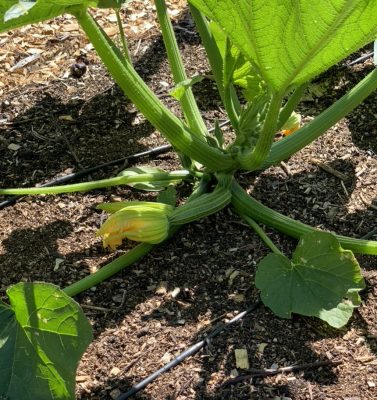 I grow only Sweet Mama and Waltham winter squashes. The first variety is botanically Cucumbita maxima and the second is C. moschata; the two species do not cross-pollinate.
I grow only Sweet Mama and Waltham winter squashes. The first variety is botanically Cucumbita maxima and the second is C. moschata; the two species do not cross-pollinate.
Plants that can self-pollinate, such as tomatoes, peppers, beans, and peas, could be contaminated by pollen from other, nearby varieties. 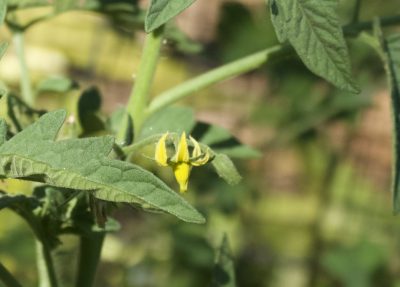 Distance between varieties can prevent cross-pollination. So can fine mesh bags. I plan to use small organza bags normally sold for wedding favors.
Distance between varieties can prevent cross-pollination. So can fine mesh bags. I plan to use small organza bags normally sold for wedding favors.
And finally, good storage, meaning dry and cool or cold conditions, makes sure seeds germinate well. Which my edamame did not. Hmmm.
(For more depth in seed saving, see the excellent and thorough book Seed to Seed: Seed Saving and Growing Techniques for Vegetable Gardeners by Suzanne Ashworth.)

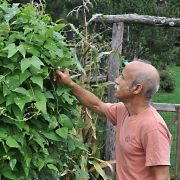

Organza bags used as wedding favors. My favorite part.
Greetings!
I presume you did not find any of the edamame seeds you planted unsprouted in the soil. When I planted sunflowers last year, chipmunks dug up every one of them within days, leaving tiny craters to remind me of their visit. This year, I left a board on top of the seeds in the ground, until the sprouts made their appearance.
By the way, I think I know who enjoyed your edamame seeds!
Who? Not chipmunks. I rarely see one, thanks to outdoor dogs and a cat. So rare are they that I still consider them to be cute little creatures; they make me smile rather than scowl.
I totally agree: Chipmunks are cute. But they do carry ticks, so I consider them a “Bad Neighbor.” Not to mention the garden damage, which is preventable.
We love to feed the birds, since they effectively control our bug population (and we live right by the river). But that bird feeding caused the Chipmunk population to explode. Recently I figured out how to recover the dropped bird food, so I will not have that problem next year. Last year, I kept a count of the cute chipmunks I caught, about 45 of them. This year, I am to busy to count.
Being a retired teacher, I would be remiss if I did not add this note: We place Permethrin soaked cotton balls inside toilet-paper tubes around our lawn. Mice and Chipmunks take the cotton to their nest, where the Permethrin kills the ticks on their hosts. I have evidence that this is an effective tick control. I highly recommend it.
Thanks for the good information about tick control.As far as the chipmunks, you need an outdoor dog or two.
Had the same happen w/ peas 2 years ago. Best I could guess was birds, may be grackles. I could not find any evidence of the soil being disrupted but an occasional small (< the size of a pencil eraser) hole in the row.
Many years ago I had problems with grackles on my peas, eating the pods. No longer. I didn’t see any holes at all in the soil but my soil is very loose so they could have covered over.
Thank you so much for this timely post! I love my seeds, and I do try and keep them as long as they are viable. But I, too, have been noticing that, for instance, my lima bean seed was only a couple years old, had a very poor germination rate. Less than half emerged. Yet my True Red Cranberry shell beans which are 4 years old did just fine. I am beginning to wonder about sourcing, and what we are actually getting when we order through the mail. I do use Fedco seed as well, but I like to try different cultivars of veg so I order from 4-5 companies each year. I do believe that seed scarcity could be an issue, not just from the outbreak, but from the climate/weather patterns see-sawing which could affect seed grower crops. Thanks for raising this issue, as I think we should all be thinking about how to save seed for greater food security and independence. I have most of your books and I have learned so much. The work matters, and your farmden is inspiring.
Thanks so much for that accolade.
Waking up to saving one’s own seeds or otherwise making sure one has a good supply of locally robust seeds is a benefit of the pandemic. Every little bit of awareness, humility and self-responsibility helps. We are being called to make lemonade out of lemons. (Strawberry rhubarb pie out of rhubarb? You get the idea. ;)) Nature is generous and we are resilient if we open our minds. Thank you, Lee.
I checked into saving seeds, okra has to be 150 feet from other varieties of okra, that includes neighbor hood gardens.
This is no a problem for gardener with two or more lot on different streets or two acres or more in one lot. I have beed told to plant tall corn between the two varieties will help also. That one you nail with great success.But how do small gardeners save seed when they plant more than one varieties in a small plot?
Hnad pollinate and then bag flowers. As I wrote, I’m planning to use organza bags. They’re easy to attach and allow for air circulation.
Speaking of bags, do you ever bag fruit, e.g., apples, plums, etc., and, if so, what sort of bags do you use? Thanks!
Yes, I do bag some fruits. Every year I bag 100 bunches of grapes, as described at https://leereich.com/2016/09/bacteria-and-fungi-and-grapes-oh-my.html. I also have a youtube video about bac=gging grapes. Sometimes I also bag apples. This year I’ll try out the organza bags for some apples and grapes.